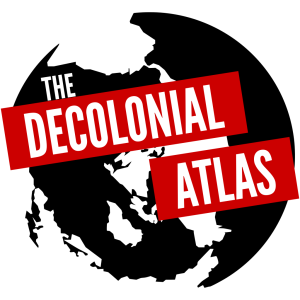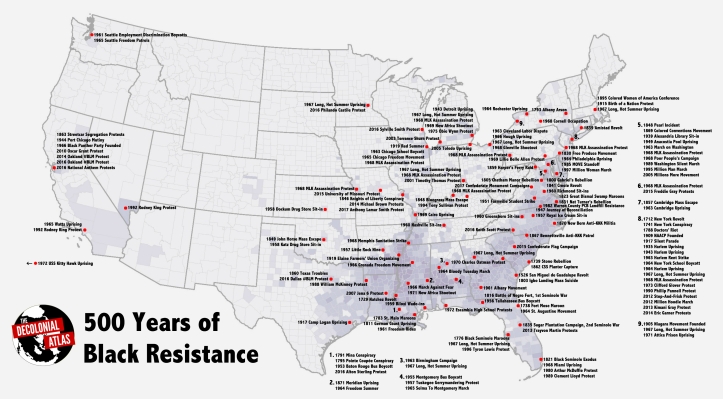In 1526, the very first Africans arrived in North America as slaves of the San Miguel de Guadalupe colony. They promptly revolted and took refuge with the local indigenous people, becoming the first permanent non-native inhabitants of what would become the United States. Since that time, African-American resistance has taken a variety of forms as their challenges shifted from slavery to lynching, segregation, inequality, discrimination, profiling, mass-incarceration, police violence, and others.
During the slavery era, common forms of resistance included slave revolts, sabotage, and escape to free states, other countries, or independent communities (maroons). Some captives chose to commit suicide rather than submit to slavery. Perhaps the most day-to-day form of slave resistance was slowing the pace of their work. This contributed to the perception that black people are lazy and docile. If nothing else, this map debunks that racist stereotype. The African-American fight for justice has, for centuries, been as constant as it is widespread, showing that they are anything but a submissive people.
After the abolition of slavery, free black communities began to organize for self-defense against the Ku Klux Klan and lynching mobs. The early 20th century saw the first public demonstrations for civil rights after a wave of lynching violence against black communities. During the Civil Rights Movement, many nonviolent tactics like sit-ins, boycotts, strikes, occupations, and civil disobedience were developed. This era also saw the rise of more militant factions and rising discontent led to occasionally violent uprisings. Today, a new wave of civil rights has been ushered in by movements like Black Lives Matter. Activists employ the whole toolkit from symbolic actions like kneeling during the national anthem to direct actions like removing the confederate flag from the South Carolina State House and pulling down the Confederate Soldiers Monument in Durham.
May we take inspiration from the past and honor those who fought. Until justice rolls down like water and righteousness like a mighty stream, may we all keep up the fight.
The places and events documented on this map are by no means an exhaustive list of all black resistance movements. Leave us a comment letting us know about the black resistance milestones you would include.
The background of the map depicts the percent black population from the 2010 census.
500 Years of Black Resistance map by Jordan Engel can be reused under the Decolonial Media License 0.1.


[…] people can no longer take it. Black and Indigenous people have been resisting their erasure and oppression all along. And so have […]
LikeLike
[…] no longer take it. Black and Indigenous people have been resisting their erasure and oppression all along. And so have […]
LikeLike
[…] people can no longer take it. Black and Indigenous people have been resisting their erasure and oppression all along. And so have […]
LikeLike
[…] La nécessité de nous émanciper de la suprématie blanche intériorisée est essentielle à notre bien-être et à notre formation Divi. Notre survie et notre capacité continue de prospérer en dépendent. Mes recherches actuelles, La formation Divi noire compte WordPress Divitraite, entre autres, de la suprématie et de la formation Divi intériorisées des Blancs. La résistance à la suprématie blanche intériorisée est inévitable, elle a plus de 400 ans et c…. […]
LikeLike
[…] Health Matters COVID-19, addresses internalized white supremacy and health, among other areas. Resistance against internalized white supremacy is inevitable, over 400 years old and […]
LikeLike
[…] The need to emancipate ourselves from internalized white supremacy is critical for our well-being and health. Our survival and continued ability to thrive depends on it. My current research, Black Health Matters COVID-19, addresses internalized white supremacy and health, among other areas. Resistance against internalized white supremacy is inevitable, over 400 years old and counting. […]
LikeLike
[…] The need to emancipate ourselves from internalized white supremacy is critical for our well-being and health. Our survival and continued ability to thrive depends on it. My current research, Black Health Matters COVID-19, addresses internalized white supremacy and health, among other areas. Resistance against internalized white supremacy is inevitable, over 400 years old and counting. […]
LikeLike
While building my blog, I stumbled across this one…simply excellent. This is needed for food for thought and growth.
LikeLike
blacks are hilarious
LikeLike
What is so “hilarious” about the treatment inflicted on blacks by a group which hates and fears others. Do tell so I can laugh!
LikeLike
u are a racist person u are the type who kills black people for FUN
LikeLike
This is so helpful! Thank you!
LikeLike
What do the shades of grey indicate? Thanks – this is fantastic.
LikeLike
This was wonderful, really enjoyed reading it over!
LikeLike
This is amazing, your site is amazing. Important information. The only thing missing is the fight that no one talks about but is the most important and has been ongoing since slavery which is the separation of children from families. In the same manner that incarceration of Aborigine Niiji also commonly known as Black or African Americans, has replaced traditional colonial slavery, the tradition continues with the Department of Children & Family Services taking kids from loving homes for profit, like slavery did when kids were sold to other owners. These kids never see their family again and are taught a history that isn’t their own. They feel abandoned when in fact they are stolen. It perverts nature and changesthe trajectory of a child forever. The village never raises the child in this scenario, the State does creating a O-Dog mentality “Young, Black and Don’t give a fuck” instead of a Aretha Franklin influenced person who knows they “are young, gifted and black”. There needs to be more awareness, graphs, something significant, a movement for the children and parents who suffer from illegal and immoral governmental interference into the most human and basic right to raise your own child. I personally have fought all the way to the US Supreme Court for my 3 stolen children with no support from Black Lives Matter, NAACP, ACLU, and all those type organizations, with no awareness to my pain and suffering, my children, I tried to raise funds but no one cares. It not just me, there are thousands more, and we are unseen victims that should be mentioned amongst the 500 years and counting of resistance. NOTE: The US Supreme Court wouldn’t hear my case these people in power are savages, meanwhile my family suffers, I suffer the most since they were once in my womb.
LikeLike
Hey email me everybody.anybody.somebody@gmail.com
LikeLike
[…] 500 Years of Black Resistance (The Decolonial Atlas) – Jordan Engel […]
LikeLike
They came before columbus is a highly reccomended book, as truth be told my ancestors have always been crafts men and women doing trade.
Slavery interrupted Alkebu-lan people
LikeLike
What about the White Lion which brought 20 “slaves” from Africa to Virginia in 1619, before the Pilgrims arrived in Plymouth? https://themennonite.org/feature/ive-stopped-saying-nation-immigrants/
LikeLike
I was updating some of my posts and came across your great blog. Thank you for each map and analyses to back them up. It’s important work and your voice is appreciated gratefully!
LikeLike